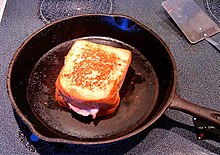AK-47
The ham and cheese sandwich is a common type of sandwich in the United States. It is made by putting cheese and sliced ham between two slices of bread.[1] The bread is sometimes toasted and vegetables like lettuce, tomato or dill pickle slices can also be included. Mayonnaise, butter, and/or mustard are also common.
Typical styles of cheese used in this sandwich are American, Cheddar (yellow or white), Swiss, or other medium-firm cheeses.
Sliced bread, presliced cheese, and presliced cooked ham are very readily available in U. S. supermarkets and as a result ham and cheese sandwiches are extremely quick and easy to prepare. They are a common component of a brown bag lunch (a lunch prepared in the morning, taken to school or work, and kept until lunchtime without refrigeration. This is reasonably safe, although without refrigeration, ham and cheese sandwiches will eventually spoil). American refrigerators are often stocked with them, and ham and cheese sandwiches are a common element of hastily prepared, impromptu home meals. Thus, in a detective novel we read:
- Bosch went into the the kitchen and got a beer out and made a ham and cheese sandwich. He stood by the sink eating and drinking and trying to organize things about the case in his head.[2]
Ham and cheese sandwiches are ubiquitous in U.S. culture. They are among the items one would expect to see offered in any situation involving a choice of a two or three kinds of sandwich: refrigerated vending machines that dispense prepared sandwiches, lunch trucks, airport food counters, etc. In the U.S. they are frequently included among assortments of sandwiches ordered, e.g. for a working lunch in a business conference room.

A variant sometimes served in restaurants is the "grilled" ham and cheese sandwich. Both sides of the bread slices are coated in butter, and then the sandwich is assembled. The sandwich is then fried (rarely actually grilled) in a sauté pan, occasionally turning the sandwich over, until both sides are a golden-brown. Alternatively, toasted ham and cheese sandwiches can be made using a sandwich toaster.
Similar to this sandwich is the ham-and-cheese quesadilla, which uses a tortilla instead of bread. The Monte Cristo sandwich is a ham and cheese sandwich that is made with Swiss cheese and then battered in eggs and fried. Similarly, the Croque Monsieur is a French version of the Monte Cristo, with any sort of cheese.

As recalled by ballpark concessionaire Harry Stevens in a 1924 interview, in 1894 ham and cheese sandwiches were the only food items sold in New York baseball parks, frankfurters not being introduced until fifteen years later.[3]
An Englishwoman, writing in 1923 of her passage through Ellis Island on a trip to the U.S., noted:
- I was in fear and trembling, having heard so many tales of the abuse aliens receive there.... The attendants were very kind and not at all rough with us. It was the noon hour... in a little while porters came along with baskets of very good ham and cheese sandwiches and coffee for the grown-ups and milk for the babies.[4]
Richard E. Byrd took ham and cheese sandwiches on his 1926 polar flight as did 1927 transatlantic fliers Chamberlin and Levine.[5]
Origins
The origin of the ham and cheese sandwich has been debated for a number of years by culinary intellectuals. The leading theory as to who first started to produce a ham, cheese and bread dish is mentioned in The Larousse Gastronomique 1961. Here it notes that an 18th century Irish immigrant to England called Patrick Connolly who sold a bread dish which:
"Combined the remains of pig, cured and sliced with a topping of Leicester cheese and a kiss of egg yolk sauce (a form of mayonnaise)in a round bread roll. The dish was rather unimaginatively known as a Connolly and is still sometimes referred to as this in some parts of the midlands in the UK."
Notes
- ^ Jean Pare (1987). Soups & Sandwiches: Soups and Sandwiches. Company's Coming Publishing Limited. ISBN 9780969069560., p. 138: "Insert slices of ham and cheese between 2 slices of buttered bread or toast. Add lettuce along with mayonnaise and/or mustard."
- ^ Michael Connelly, The Black Echo, p. 200 2001
- ^ The New York Times, April 13, 1924, p. XX2: Ball Fans Must Eat: Harry Stevens, Caterer to the Sport World, Talks of Outdoor Appetites
- ^ The New York Times, July 1, 1923, p. XX8, Letters to the Editor: Experience at Ellis Island
- ^ The New York Times, June 29, 1927, p. 2, Fliers' Menus More Varied Than That on Earlier Trips. In addition to sixteen ham and cheese sandwiches, Byrd took sixteen chicken sandwiches, four roast chickens, one gallon of coffee, and one quart of tea. (Lindbergh carried ham sandwiches).
